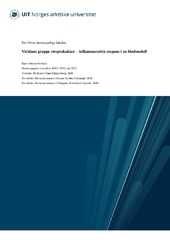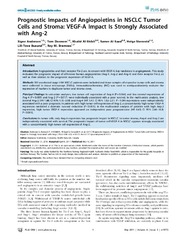The interaction between Staphylococcus aureus SdrD and desmoglein 1 is important for adhesion to host cells
Permanent lenke
https://hdl.handle.net/10037/9518Dato
2016-02-29Type
Journal articleTidsskriftartikkel
Peer reviewed
Forfatter
Askarian, Fatemeh; Ajayi, Clement; Hanssen, Anne-Merethe; Van Sorge, Nina M.; Pettersen, Ingvild; Diep, Dzung Bao; Sollid, Johanna U. Ericson; Johannessen, MonaSammendrag
Staphylococcus aureus is known as a frequent colonizer of the skin and mucosa. Among bacterial factors
involved in colonization are adhesins such as the microbial surface components recognizing adhesive
matrix molecules (MSCRAMMs). Serine aspartate repeat containing protein D (SdrD) is involved in
adhesion to human squamous cells isolated from the nose. Here, we identify Desmoglein 1 (Dsg1)
as a novel interaction partner for SdrD. Genetic deletion of
sdrD in S. aureusNCTC8325-4 through
allelic replacement resulted in decreased bacterial adherence to Dsg1- expressing HaCaT cells
in vitro.
Complementary gain-of-function was demonstrated by heterologous expression of SdrD in Lactococcus
lactis, which increased adherence to HaCaT cells. Also ectopic expression of Dsg1 in HEK293 cells
resulted in increased adherence of S. aureus
NCTC8325-4 in vitro. Increased adherence of NCTC8325-4, compared to NCTC8325-4ΔsdrD,
to the recombinant immobilized Dsg1 demonstrated direct interaction between SdrD and Dsg1. Specificity of SdrD interaction with Dsg1 was further verified using flow
cytometry and confirmed binding of recombinant SdrD to HaCaT cells expressing Dsg1 on their surface.
These data demonstrate that Dsg1 is a host ligand for SdrD.
Beskrivelse
Source at http://doi.org/10.1038/srep22134
Er en del av
Ajayi, C. (2018). Determinants of Staphylococcus aureus Colonization and Infection. “Exploring the Role of Cell Wall Anchored Proteins in Adhesion and Immune Evasion”. Doctoral thesis. http://hdl.handle.net/10037/14070Forlag
Nature Publishing GroupSitering
Askarian, F., Ajayi, C., Hanssen, A-M., van Sorge, N.M., Pettersen, I., Diep, D.B. ... Johannessen, M. (2016). The interaction beween Staphylococcus aureus SdrD and desmoglein 1 is important for adhesion to host cells. Scientific Reports, 6, 22134. http://doi.org/10.1038/srep22134Metadata
Vis full innførselSamlinger
Relaterte innførsler
Viser innførsler relatert til tittel, forfatter og emneord.
-
Viridans gruppe streptokokker – inflammatorisk respons i en blodmodell
Broback, Bjørn Martin (Master thesis; Mastergradsoppgave, 2022-05-31)Bakgrunn: Viridans gruppe streptokokker (VGS) er en heterogen gruppe med bakterier som er sett på som opportunistiske bakterier. De har nå blitt en vanligere årsak til alvorlig sepsis hos nyfødte og immunsupprimerte barn. Formålet med denne studien er å sammenligne immunresponsen til en VGS bakterie (Streptococcus mitis) mot en gruppe B streptokokk (GBS) og Staphylococcus haemolyticus i en ex vivo ... -
Prognostic Impacts of Angiopoietins in NSCLC Tumor Cells and Stroma : VEGF-A Impact Is Strongly Associated with Ang-2
Andersen, Sigve; Dønnem, Tom; Al-Shibli, Khalid Ibrahim; Al-Saad, Samer; Stenvold, Helge; Busund, Lill-Tove; Bremnes, Roy M. (Journal article; Tidsskriftartikkel; Peer reviewed, 2011)Angiopoietins and their receptor Tie-2 are, in concert with VEGF-A, key mediators in angiogenesis. This study evaluates the prognostic impact of all known human angiopoietins (Ang-1, Ang-2 and Ang-4) and their receptor Tie-2, as well as their relation to the prognostic expression of VEGF-A. 335 unselected stage I-IIIA NSCLC-patients were included and tissue samples of respective tumor cells and ... -
The Temporomandibular Joint in Juvenile Idiopathic Arthritis, focusing on Quality of Life, Oral Microbiome and Intervention
Frid, Paula (Doctoral thesis; Doktorgradsavhandling, 2020-10-02)The temporomandibular joint (TMJ) is commonly involved in juvenile idiopathic arthritis (JIA), and may lead to impaired mouth opening, pain and facial growth disturbances. Asymptomatic TMJ arthritis may be diagnosed late in the disease course, thus management is challenging. The overall objectives of this thesis were to provide new knowledge on quality of life (QoL), the oral microbiome and interventions ...


 English
English norsk
norsk


